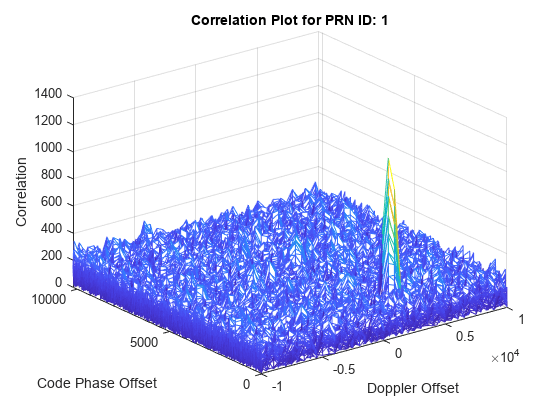gnssSignalAcquirer
Description
The gnssSignalAcquirer
System object™ detects signals emanating from a given global navigation satellite system (GNSS)
satellite constellation. The object also estimates the coarse values of the code-phase offset
and the frequency offset.
The object supports acquiring these satellite signals.
To acquire a GNSS signal:
Create the
gnssSignalAcquirerobject and set its properties.Call the object with arguments, as if it were a function.
To learn more about how System objects work, see What Are System Objects?
Creation
Description
gsa = gnssSignalAcquirer
gsa = gnssSignalAcquirer(Name=Value)gnssSignalAcquirer(GNSSSignalType="QZSS C/A") sets the type of the
GNSS signal to "QZSS C/A".
Properties
Usage
Description
Input Arguments
Output Arguments
Object Functions
To use an object function, specify the
System object as the first input argument. For
example, to release system resources of a System object named obj, use
this syntax:
release(obj)
Examples
References
[1] IS-GPS-200, Rev:N. "NAVSTAR GPS Space Segment/Navigation User Segment Interfaces." GPS Enterprise Space & Missile Systems Center (SMC) - LAAFB, Aug 22, 2022.
[2] IS-GPS-800, Rev:J. "NAVSTAR GPS Space Segment/User Segment L1C Interfaces." GPS Enterprise Space & Missile Systems Center (SMC) - LAAFB, Aug 22, 2022.
[3] ISRO-IRNSS-ICD-SPS-1.1. "Signal in Space ICD for Standard Positioning Service." ISRO satellite navigation programme. August 2017.
[4] IS-QZSS-PNT-004. "Quasi-Zenith Satellite System. Interface Specification. Satellite Positioning, Navigation and Timing Service." Cabinet office, Government of Japan. January 25, 2021.
[5] IS-GPS-705, Rev:J. "NAVSTAR GPS Space Segment/User segment L5 Interfaces." Aug 22, 2022.
[6] Ward, P.W. “GPS Receiver Search Techniques.” In Proceedings of Position, Location and Navigation Symposium - PLANS ’96, 604–11. Atlanta, GA, USA: IEEE, 1996. https://doi.org/10.1109/PLANS.1996.509134.
[7] Kaplan, Elliott D., and C. Hegarty, eds. Understanding GPS/GNSS: Principles and Applications. Third edition. GNSS Technology and Applications Series. Boston; London: Artech House, 2017.
